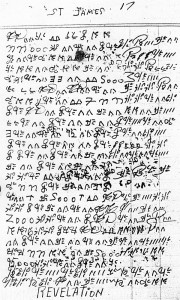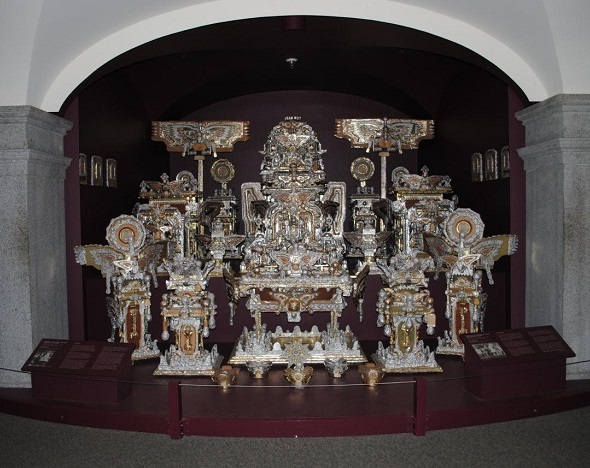Outsider artist James Hampton left behind an encrypted notebook and a sculpture bearing a few encrypted labels. When I was in Washington, D.C., recently, I took a video of both.
James Hampton (1909–1964) was an African-American janitor and cook, who spent most of his life in the Washington, D.C., area. Only after his death, it was discovered that he had created a marvelous religious sculpture made from scavenged materials. Today, James Hampton, who was completely unknown during his lifetime, is considered an outsider artist.
James Hampton’s sculpture, which is the only artwork he left behind, is titled The Throne of the Third Heaven of the Nations’ Millennium General Assembly. It is on display at the Smithonian American Art Museum in Washington, D.C..
Hampton was very religious. His sculpture has the appearance of an altar. As Hampton was not especially wealthy, he used only cheap material to assemble his artwork, such as cardboard, glass, and aluminium foil.
A video
Hampton’s sculpture comprises a number of lables that bear an unknown writing. The same kind of writing (also known as Hamptonese) can be found in a notebook Hampton left behind. This notebook has over a hundred pages filled with Hampton’s strange script. It is completely unknown what these Hamptonese messages mean.

Source: Smithsonian Museum of American Art
When I was in Washington, D.C., last Sunday, I took the chance to visit the Smithsonian Museum and to take a look at the sculpture. Though it was not the first time I saw it, I was quite impressed. I took a two-minutes video that shows both the sculpture and the notebook. Here it is:
About Hampton’s cryptograms
In my view, James Hampton’s notebook is the third most important unsolved encrypted book – after the Voynich Manuscript and the Rohonc Codex. I therefore put it at the third position (00003) of my encrypted book list.
Of course, there are many theories about the encrypted (?) writing in Hampton’s notebook and on his sculpture. Hamptonese could be encrypted text, but if so, it is unclear which encryption method was used. It was certainly not a pure MASC. Phonetic English is another possible explanation.
There’s also a possibility that Hamptonese is based on a foreign language. This language might be Gullah, an English-based creole spoken by black people in some parts of the USA. While Gullah was probably not Hampton’s native language, it seems possible that he learned to speak it. Chamorro, a language spoken on two islands in the Pacific Ocean, is a candidate, too. Hampton might have got to know this idiom during his military service in the Southern Pacific. It probably takes a linguist to validate these language hypotheses.
It is also possbile that Hamptonese has no meaning at all. Perhaps, Hampton believed that he was receiving messages from god and that he tried to write these down. Such a phenomenon is referred to as automated writing.
To learn more about Hampton’s encrypted documents, check the websites of Dennis Stallings (Dennis, who is also a Voynich Manuscript expert, was the one who discovered Hampton’s notebook for the crypto scene) and Mark Stamp. My book Nicht zu knacken contains a chapter about this topic, and so does Craig Bauer’s book Unsolved!.
Here are scans of all pages. And here’s a transcription. Good luck solving it!
Follow @KlausSchmeh
Further reading: Top 50 crypto mystery solved: Thomas Ernst deciphers Fredinand III’s encrypted letters
Linkedin: https://www.linkedin.com/groups/13501820
Facebook: https://www.facebook.com/groups/763282653806483/



Letzte Kommentare